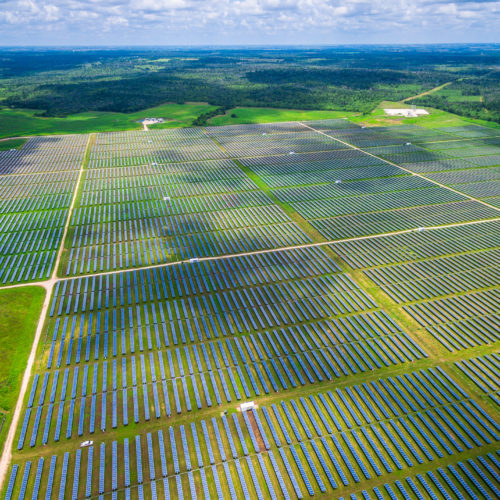
Banking on Renewables: Inside a Milestone Renewable Energy Deal
Last week, Goldman Sachs (GS) became the first U.S. bank to sign a large-scale, off-site renewable energy power purchase agreement (PPA) to enable the development of a new 68 megawatt (MW) Pennsylvania wind farm.
At a time when many large companies are looking to renewables to help fulfill ambitious sustainability commitments—GS’s goal is to reach 100 percent renewable energy by 2020—Rocky Mountain Institute’s Business Renewables Center (BRC) is working to streamline the transaction process and help catalyze more of these deals across industries.
The BRC’s Mark Porter sat down with Cindy Quan, Harry Singh, and Kevin Smith at GS to discuss the bank’s wind deal and learn more about its business case, the transactional experience, and lessons learned that other companies should consider when exploring deals of their own.
BRC: What were some of the factors that led GS to enter into a PPA now and how does it fit into your overall sustainability goals?
Kevin Smith: Since the initial release of our 2005 Environmental Policy Framework, which formalized our commitment to the environment, the firm has made significant progress as one of the leading financiers and investors in the clean energy sector. In late 2015, we released an updated Environmental Policy Framework that established an even more ambitious road map across each and every one of our businesses to harness market solutions to address critical environmental issues. Among our initiatives are a number of business and operational targets, including an expanded target of $150 billion in clean energy financings and investments by 2025.
In our operations, we challenged ourselves to increase our commitment to reducing our footprint and to do so in a way that would help catalyze the market for clean energy beyond our traditional investment and financing activities. We established a target to achieve 100 percent of our global electricity consumption through renewables by 2020 and to do so in a way that is commercially beneficial. In 2016, we procured renewable energy certificates equivalent to 90 percent of our global electricity consumption and 100 percent of our U.S. electricity consumption. This year, we wanted to further advance our efforts by serving as a creditworthy off-taker to facilitate the development of a new wind project.
BRC: What factors did you consider in selecting the PPA and how do you view the significance of the PPA location?
Cindy Quan: We wanted to closely match the generation of clean energy with the location of our consumption. There were several considerations in selecting the PPA, including competitive pricing, power market fundamentals, technology, environmental impact, and proximity to the location of our consumption. We concluded that the project’s proximity was one of the most important factors for us to effectively manage power market risk. In our case, this led us to a PPA in Pennsylvania within the PJM grid, which happens to be a large and liquid power market and within the same regional grid as the majority of our U.S. load.
BRC: For an entity that already transacts in physical power markets, what made you select a virtual PPA structure for this transaction over a physical PPA?
Cindy Quan: We considered many PPA structures at the onset and decided on a virtual structure based on our location within the PJM market. This structure allowed us flexibility to closely match the wind generation with our consumption profile without taking on additional operational and transactional complexities. Our J. Aron commodities business has FERC market-based rate authorization, should we ever need to convert to a physical PPA. It’s also worth highlighting that even under a physical PPA, renewable energy from a specific resource would not flow directly to our facilities and power our usage. Rather, we’d be purchasing an amount of electricity from the renewable facility that appropriately matches our consumption.
BRC: What were some of the PPA options and risks you considered and how did you address them (e.g., additionality, basis risk, potential downside due to saturation of renewables)?
Harry Singh: The additionality component was a key driver for the PPA, as we were focused on enabling the development of new renewable generation. Ensuring the appropriate accounting treatment for the PPA was also an important consideration. For example, the transaction structure (fixed volume or as-generated) and other contractual terms can influence what type of accounting treatment is required. This made us involve our accounting team early on in the process. While selecting a location that was in regional proximity to our consumption was a significant factor in addressing market risk, we also considered shape risk (i.e., mismatch between the profiles of the wind generation and those of our consumption) and basis risk (i.e., price difference between the wind farm and the location of our consumption). We were able to get comfortable with these risks by relying on J. Aron’s commodity risk management infrastructure. J. Aron is a market maker in basis swaps, which can be used to hedge basis risk and also enable an arrangement for firming and shaping of the delivered energy. We found PJM to be an attractive region from an environmental impact perspective and because it didn’t have the same exposure to renewable saturation that can raise curtailment and negative pricing issues, as witnessed in some other regions.
BRC: This is one of the first corporate PPAs by a financial institution with a new renewable project. What were some of the unique features and challenges involved in the PPA?
Harry Singh: The collaboration between our J. Aron commodity business, our Corporate Services and Real Estate Group, and the Environmental Markets Group is a unique feature of the transaction that enabled the firm to meet its operational and sustainability goals while leveraging our commercial expertise in power markets to design an optimal structure for managing the commodity risk in the PPA as well as addressing certain reporting requirements. While several firms have signed renewable PPAs to address sustainability goals, to our knowledge this is the first such transaction by a U.S. bank to contract for the entirety of a new renewable energy project, enabling the development of the 68 MW wind project. This transaction also required creative thinking and the development of new processes to meet market regulations specifically applicable to banking entities.
BRC: If you were to do it all over again, what would you do the same and what would you change?
Cindy Quan: We’d likely pursue the same PPA structure and grid location as our current project as it offers us the best possible options for aligning with our consumption goals and risk appetite. We learned a lot from this transaction and if we had to do it over, we would do it faster, having already gone through the process and understanding our key drivers and priorities for the PPA. Our experience also highlighted the benefit of an early partnership with our commodities business, which we would engage at the onset.
BRC: With the U.S. pulling out of the Paris Agreement, has Goldman’s approach to the environmental space changed?
Kevin Smith: The firm has made public commitments to address climate change by mitigating our operational impact on the environment and leveraging our businesses to promote and scale up environmental market solutions. We stand behind those commitments and are well on our way toward achieving our 2020 goal for 100 percent renewable energy and our 2025 goal to deploy $150 billion to clean energy through our financing and investment activity. This transaction represents a continuation of our leadership and commitment to the renewable energy sector as we work toward a cleaner future.
More broadly, we believe that the business case for renewables remains compelling. Technology innovation, including significant cost reductions, as well as market dynamics will continue to drive growth in the low-carbon economy, despite potential policy uncertainty. As a firm, we take a commercial approach and these drivers make an ever more compelling business case for us.
____________________________
Cindy Quan is a vice president and global head of the Environmental, Social and Governance in Goldman Sachs’ Corporate Services and Real Estate Group.
Harry Singh is a vice president in Goldman Sachs’ U.S. Power Trading Group.
Kevin Smith is a vice president in the Goldman Sachs Environmental Markets Group.


